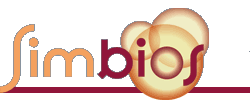Preface
DBPs are driving biomedical problems, funded by separate peer reviewed NIH awards. The Simbios contribution is to work closely with DBP scientists to understand their needs, and create software that helps solve important problems within that biomedical area. The Simbios resource allocation for an active DBP can take several forms, including some combination of:
- Effort from a professional programmer
- Student support
- Post-doc support
- Faculty salary support, travel, supplies
- "PR" to push for collaborations in this area
- Other
NIH has mandated that DBPs change over time. As a new DBP is added, funding allocated to a previously active DBP may be reduced or stopped. When this occurs, the DBP should not be terminated, phased out, or killed. Instead, we expect that previously supported DBPs should “graduate” and make a successful transition. The difference is that the software building activity at Simbios may be reduced, but we strive to have a plan for continued scientific activity and support for development of software by other means, as detailed below.
Scenarios for graduation
A. Software is mature and available at Simtk.org.
PI of DBP (alone or in combination with PI of Simbios) takes responsibility for maintenance of this software. It is important to encourage the formation of user groups that will over time support code and extend it. Most elements of the Simtk core fall in this category.
EXAMPLES: SimTK core (including Simbody) expected outcome. OpenSim likely outcome. OpenMM likely outcome. Simbios likely to provide low-level support, but without significant additional resources. This is an excellent outcome and is a major challenge to do well.
B. Software is mature, and company licenses it for extension and augmentation.
The open source free version always remains in Simtk.org, but Simbios may have relationship with a company that uses this as their basis.
EXAMPLE: Simvascular.
C. Software is still in development, with scientific studies underway to show its value.
Open source version is released and available on Simtk.org, but scientists are still using it to establish its value in the application domain. The PI may allocate R01 (or other) resources for computational effort, new grants may be written, new fellowships attracted, so that the DBP continues but with minimal Simbios support. Simbios may retain some involvement if the potential for impact is great.
EXAMPLE: Multibody modeling of molecules (RNA and myosin), which depends on SimTK core software (in particular Molmodel and Simbody) but which may not be associated with a finished tool at the time of graduation.
New DBPs that leverage existing code base
In many cases, it is best for a follow-on DBP to have technical (software) overlap with previous DBPs so that the expertise of the team and the "head start" on the code can be leveraged. For example, Simbios has significant expertise in molecular dynamics, and three of the (former and new) DBPs fall into this category. OpenSim was originally developed to create patient specific simulations of children with cerebral palsy. Follow on DBPs that focus on movement dynamics in subjects with stroke, osteoarthritis, limb loss, or Parkinson’s disease could leverage the existing code base and motivate new developments.
Return to Driving Biological Projects




